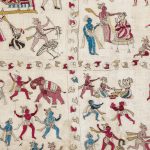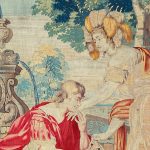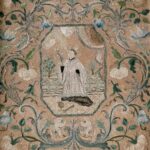A partnership between Gawthorpe Textiles Collection and Dr Rohini Arora to give an in depth look at two rare and precious examples of embroidery from the Chamba region of India.
View moreThe four Tapestries situated in the Drawing Room of Astley Hall date from the mid-17th Century and depict the mythological story of Jason and his quest for the Golden Fleece. They were made in Flanders (Northern part of Belgium) and according to the records of the Victoria and Albert Museum there are only two other […]
View moreThis yellow brocaded silk was probably intended for use as garment fabric – perhaps as a woman’s gown or a man’s coat or waistcoat. The silk has a damask weave creating a self-coloured background pattern overlaid with vibrant, colourful floral sprays that have been added with additional brocade weaving. The brocade is further enhanced with […]
View moreA Chamba rumal of cotton muslin embroidered in colourful silk threads with a design depicting four figures on horseback and floral borders. Chamba rumal embroideries take the first part of their name from the small town of Chamba in the Himachal Pradesh region of India and began being produced there in the 17th century. The […]
View moreA framed colifichet embroidery depicting St Aloysius de Gonzaga worked in fine silk floss on a ground of parchment. Colifichet embroideries are a rare type of double-sided embroidery that are stitched meticulously so that each side appears the same. As shown in this example, they were usually specially framed so that both sides of the […]
View more










